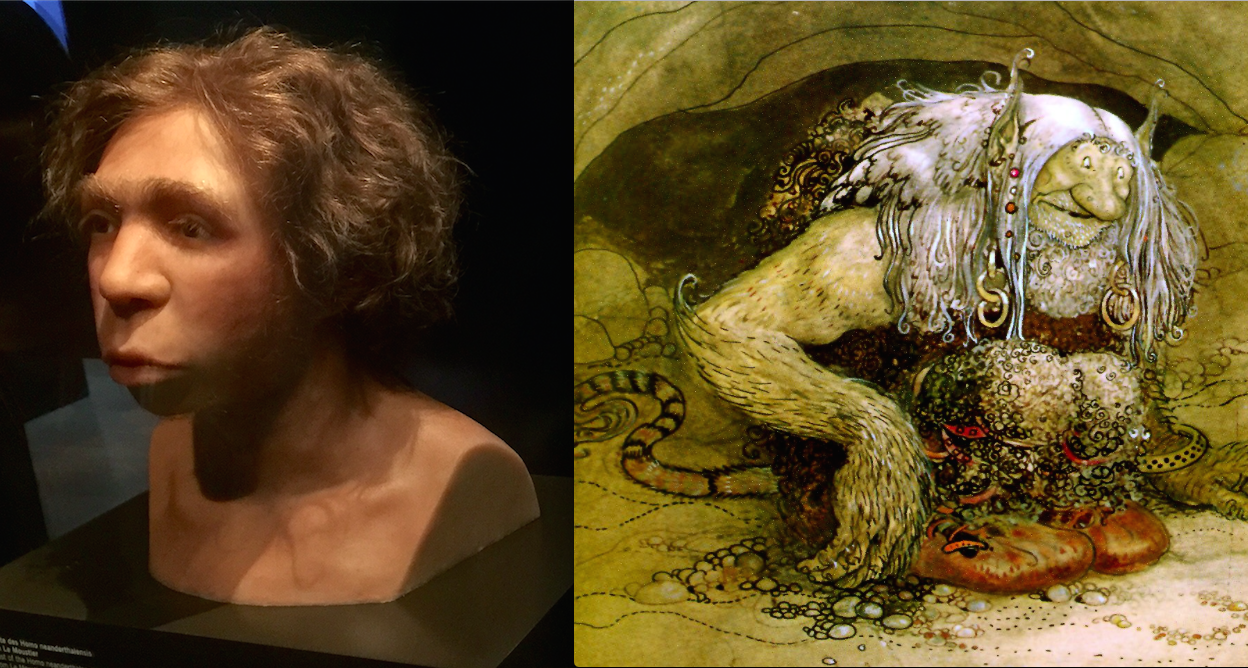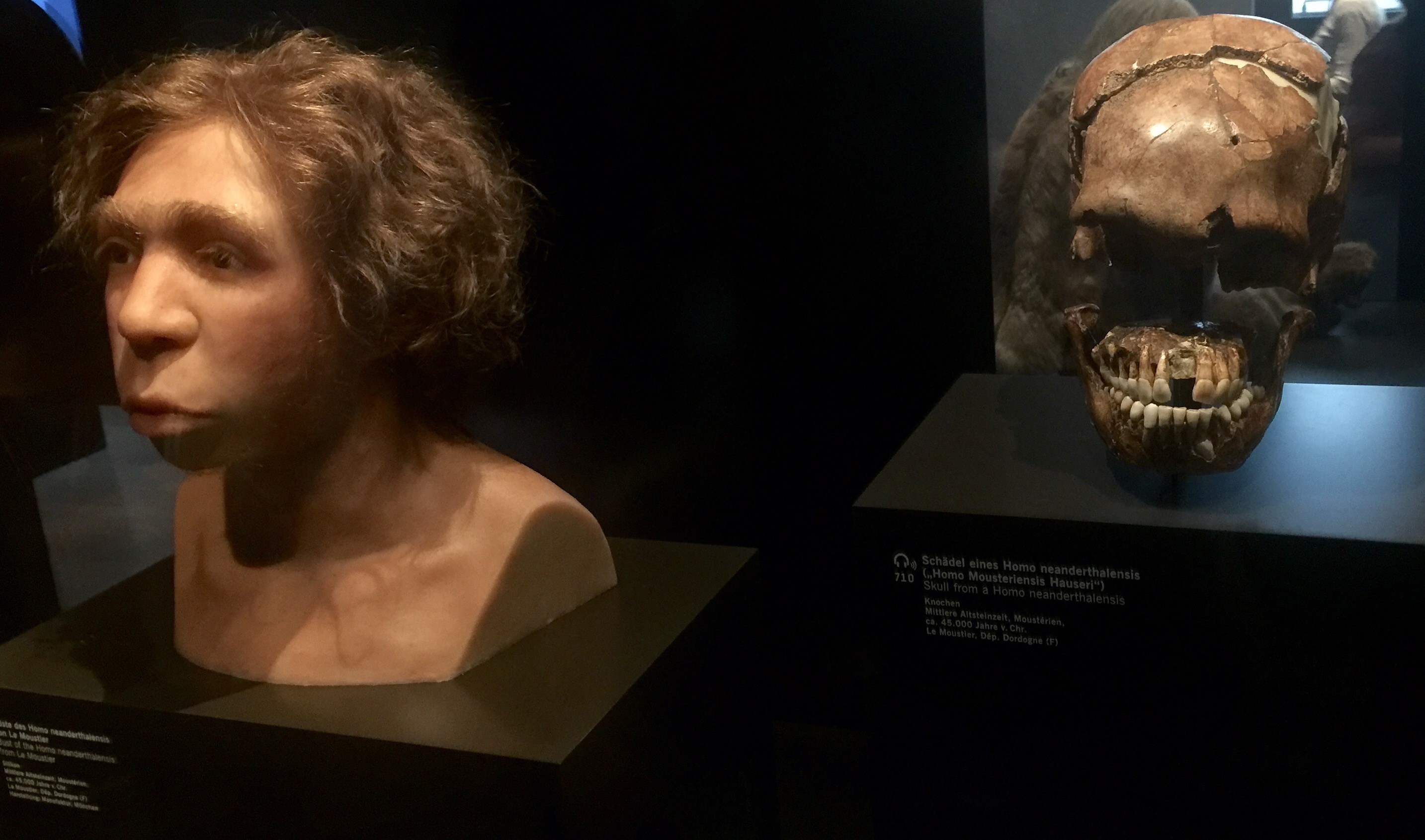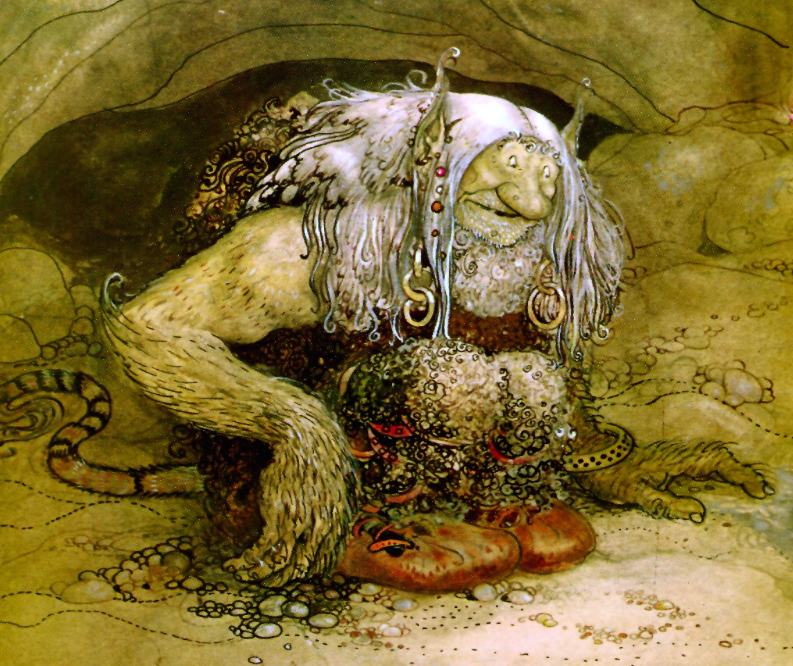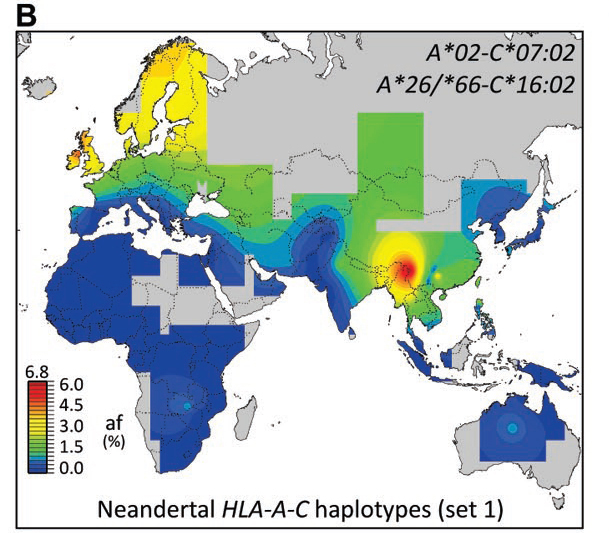By Patrick Hunt –
Neanderthal humans (Homo neanderthalensis) are documented in European contexts for around 430,000 years according to new studies,(1) and the accepted genomic contribution of Neanderthal DNA in modern Homo sapiens from Eurasia, including Scandinavian, Siberian, Asian population and the rest of Europe, with a range of around 2-4% evidences mating between the two human populations. Whether normative or occasional is less important, but episodic encounters of productive mating – estimates from at least a necessary 300 times – between the two human groups date to at least around 65,000-50,000 years ago in the Balkans and elsewhere,(2) although some suggest earlier inter-mating also going back at least 100,000 years possibly in North Africa. (3) It is now fully supportable that Neanderthals had the ability to vocalize in speech (FOXP2 gene) and that Neanderthal DNA has contributed some significant advantages to modern humans, including resistance to cold climate, among other benefits, and Neanderthal culture is no longer so simplistically derogated as previously.
Neanderthal Exhibit, reconstruction and skull, National Archaeology Museum, Chateau de Saint-Germain-en-Laye, France (photo P. Hunt 2015)
In addition to modern growing scientific study of this interaction between modern human and Neanderthals, there is also the much earlier but mostly undocumentable folkloric encounters of humans and what was considered non-human, even if legends suggest mating could produce offspring that would also be fertile. Some of the folklore beings that come up regularly in Northern European culture include trolls and the like, marginalized creatures with mostly negative personae in the long traditions. The big “what if?…” question probed here that is greatly speculative but also has intriguing potential for actual human prehistory – mostly unwritten – is whether or not trolls, for example, are vestigial human memories of Neanderthals? Fictive or not, William Golding hypothesized Human-Neanderthal interaction in his 1955 novel The Inheritors. More to the topic here, Finnish Paleontologist Bjorn Kurten was one of the first to hint at this idea of Neanderthals as Trolls in fictionalized narratives in the 1970’s-80’s (e.g., Den Svarta Tigern 1978). Another prescient Finn, Andreas Heinakroon, formerly of the Swedish Natural History Museum and trained in entomology, has also sagely popularized the possible troll : Neanderthal connection at least as early as 2012.(4)
Repeating his painted image on the top right beginning this article, modern Swedish artist John Bauer (1882-1918) created many troll caricatures with hyperbolic features such as this one.
Additionally, there are also the longstanding Scandinavian folk traditions that trolls long antedated humans in the North as the “Old Ones” and that they are usually described as unattractive relative to humans; furthermore, they were not described as socially-oriented but were presented as relatively elusive, possibly suggested as prescient about human perceptions. Trolls, however, are often difficult to define as mythical creatures with possible meanings shifting throughout Scandinavian literature, and they sometimes possess magical powers that cannot be explained by the late Sagas since Icelandic literature preserves in writing what may not have been recorded in prior Old Norse oral tales.(5) Trolls are sometimes enlarged into huge creatures when connected to the Old Jotunn or Ancient Ice Giants in Norway whose rocky abodes were along the spine of the glacially-hewn mountains of the same same name, Jotunheimen.
Some of the commonalities between known Neanderthal features and habitats and the folklore around trolls include heavy, large-boned skeleta, thick-skinned for cold insulation, cave dwellers, pronounced brows, broad-based possibly large fleshy noses, living in remote or montane topography (“mountain trolls” or bjergtrolde in Danish) or loci not considered optimum by increasingly sedentary humans, as well as the general miasma that has unfortunately colored the tradition of both Neanderthals and trolls since modern humans exemplify the old adage that the “victors write the history”. The above physical characterizations of Neanderthals can be substantiated (6), whereas those of mythical trolls cannot be verified. Subtracting the caricatures of both Neanderthals and trolls that continue to permeate historic modern culture, there is no doubt that Neanderthals exist now only in relict DNA and that trolls are not observable beings either.
Reconstructed Neanderthal (Courtesy of BBC Elizabeth Daynes Science Photo Library 2016)
The word troll or trall itself as mentioned shows up in Old Norse and may have antecedents in Proto-German as *trullan. Linguistic connections are difficult to establish in Proto-Germanic languages prior to Old Norse, especially pre-Roman, but may offer some possibilities. The meaning of the Greek word troglodyte now glossed as “Cave-men” seems a fairly old one – compounded together from at least Aristotle (4th c. BCE) in his De Partibus Animalium 669b7 but at first referencing “animals that dwell in holes” and then “Cave-Men” in other authors according to the Greek Lexicon.(7) The original meme word or idea of troll as “cave dweller” – possibly from the same root as troglodyte in Proto-Indo-European? – could even be a linguistic artifact of this possible memory, although Old Norse only has the written word troll from the Medieval period onward, as mentioned above.
It had been long argued for at least a century that no known provable Neanderthal materials can be found in Scandinavia (although present in Germanic Schleswig-Holstein just south of Denmark), with ambiguous bone and stone artifacts lacking firm stratigraphic contexts, also problematically where Scandinavian troll folklore is strongest. But new research shows that while Neanderthals also existed in Russia at the 52 ° latitude north, Scandinavia itself up to at least 55 ° latitude north – and possibly further north – could have supported Neanderthal populations through some interglacial periods until glacial periods (from the warmer Eemian 130,000-115,000 BP to the colder Early Weichsellian 115,000-11,700 BP) where the more hospitable Eemian needs further research and where the colder Weichsellian would have been problematic through much of Continental Europe (8). Furthermore, Neanderthal Mousterian Culture has now been evidenced closer around 65 ° latitude north at Byzovaya just under the Arctic Circle in Russia circa 28,500 BP by a Russo-French CNRS research team.(9) Other new research, including the Heidelberger Akademie der Wissenbchaften project (coordinated through ROCEEH, Tubingen University) on “Northern Neanderthals – A systematic assessment of pre-modern human colonization of South Scandinavia” continues this line of argument “at the extreme periphery of the Neanderthal range.” Certainly, the 36,000 year BP Kostenki Russian skeleton of an early modern human shows that Homo sapiens survived the Last Glacial Maximum (LGM) at its Ice Age peak 26,500 years BP, (10) and while it’s more difficult to date the last Neanderthal, the Gibraltar Gorham’s Cave Neanderthals can be approximated to around 28,000 years BP, (11) and Neanderthals are postulated to have continued to around 24,000 BP. In other words, even after humans migrated away southward due to inhospitable Ice Age climates, so apparently did the last Neanderthals in the Upper Paleolithic, and increasingly limited contact could have continued.
Why the Scandinavian traditions preserved troll folklore best is a conundrum if actual archaeological Neanderthal presence is so elusive in Scandinavia. But even if verifiable Neanderthal artifacts are either ambiguous or conspicuous by their absence from Scandinavia, genomics may tell a different story. The HLA Class 1 genes that are strongly associated with Neanderthals and are distinctly related to resistance to pathogens show at least for Neanderthal HLA-A-C haplotypes a much higher density around 3% in Scandinavia than the rest of continental Europe (with a higher percentage only in Northern Ireland and Scotland). Given the late Medieval phenomenon of Danelaw and Viking Expansion (ca. 9th-11th c.) when Scandinavian DNA permeated Eastern Britain and adjacent areas, this may make more sense than the dearth of Neanderthal artifacts in Scandinavia. The HLA-A-C map below is only one possible hint of this possible Neanderthal HLA genomic distribution, and while only a single marker and not conclusive in and of itself, does suggest a different story about Scandinavian Neanderthal population. The primary problem with making more of this haplogroup possibility is that Scandinavia was depopulated through much of the Ice Ages and repopulation is often post-Holocene (since 11,700 BP).
(Courtesy of Laurent Abi-Rached in Science-AAS, 2011)
Perhaps it is also helpful to remember that Glacial Ice Ages scraped clean much of continental Europe so that the surviving archaeological Upper Paleolithic contexts from Aurignacian (~40,000-28,000 BP), Solutrian (~22,000-17,000 BP), and Magdalanian (~17,000-12,000 BP) Periods and related artifact and cave art contexts from Chauvet, Lascaux, Altamira and other cave sites are found mostly fairly deep (or protected) below the glacially-altered surface even to the south in France and Spain. Note that 10-15 meters of new subsequent loess is also estimated to have been deposited, for example, in loci in Northern France from the last glaciation.(12) How much more so might this be expected then in the more heavily-glaciated North where ice sheets were so much deeper and heavier and even more landscape altering? But even an earlier folkloric tradition that returns to its original Northern roots when modern humans return cannot be dismissed outright. Thus, the possible hypothetical connection between Neanderthals as “trolls” or troglodytes remains sufficiently inviting.
Perhaps an equally germane query is whether any human folklore traditions rendering relict Neanderthals as trolls can survive this long around 28,000 years? Arguments from silence notwithstanding, it remains to be seen whether such a connection has more than literary merit, but all good questions are worth asking if they lead to more definitive answers.
Notes:
(1) Ewen Callaway. “Oldest ancient-human DNA details dawn of Neanderthals.” Nature 531 (7594), March 14, 2016, 286.
(2) S. Sankararaman, S. Mallick, M. Dannemann, K. Praefer, J. Kelso, S. Paabo, N. Patterson and D. Reich. “The landscape of Neandertal ancestry in present-day humans.” Nature 507 (7492) March 20, 2014, 354-7.
(3) Ann Gibbons. “Humans Mated with Neanderthals much earlier and more frequently than thought.” Science (Feb 16, 2016).
(4) Andreas Heinakroon, “The Troll Within Us”, March 5, 2012, (https://heinakroon.com/2012/03/05/the-troll-within-us/).
(5) Armann Jakobsson. “The Trollish Acts of Thorgrimr the Witch: The Meanings of Troll and Ergi in Medieval Iceland” in Saga-Book 32 (2008), 39.68; also reprinted in A. Jacobsson, Nine Saga Studies: The Critical Interpretation of the Icelandic Sagas. Reykjavik: University of Iceland, 2013.
(6) Wesley Niewoehner. “Behavioral inferences from the Skhul / Qafzeh early modern hand remains.” Proceedings of the National Academy of Science 98.6 (2001) 2979-84, especially relative to Neanderthals.
(7) H. G. Liddell and R. Scott, eds. Greek English Lexicon, Oxford: Clarendon Press, 1996 ed., 1831.
(8) Trine Kellberg Nielsen, B. M. Benito, J.C. Svenning, B. Sandel et al. “Investigating Neanderthal dispersal above 55° N in Europe during the Last Interglacial Complex.” Quaternary International 431B (February 2017) 88-103.
(9) L. Slimak, J. I. Svendsen, J. Mangerud, H. Plisson, H. P. Heggen, A. Brugere, P. Y. Pavlov. “Late Mousterian Persistence near the Arctic Circle.” Science 332 (6031) May 13, 2011, 841-45.
(10) A. Sequin-Orlando, T. Korneliussen. M. Sikora et al. “Paleogenomics: Genomic structure in Europeans dating back at least 36,200 years” Science 346(6213) Nov. 6, 2014, 113-18; also Research News, Cambridge University, Nov. 6, 2014: “Ancient DNA shows earliest European genomes weathered the ice age, and shines new light on Neanderthal interbreeding and a mystery human lineage” (http://www.cam.ac.uk/research/news/ancient-dna-shows-earliest-european-genomes-weathered-the-ice-age-and-shines-new-light-on).
(11) C. Finlayson, F. G. Pacheco et al. “Late Survival of Neanderthals at the Southernmost Extreme of Europe.” Nature 443(7113) October 19, 2006, 850-3.
(12) Paul Mellars. The Neanderthal Legacy: The Archaeological Perspective From Western Europe. Princeton University Press, 1996, 30.




